A
| Aboyne Jubilee Fountain |
|---|

A commemorative drinking fountain in polished pink granite with contrasting gray decorative columns. |
| Aboyne Millennium Gates |

Pair of double wrought iron gates with masonry pillars with ornamental capstones, decorated with a bronze relief showing the Marquis of Huntly's Crest (being used as the Gordon clan badge?) with a ten tined stag's head and neck affrontee issuing from a coronet and the motto Bydand. Following a suggestion from the Marquis of Huntly, the Games' Chieftain, it was decided to echo the design of the tops of the gate pillars at the Parish Church across the Green, on the gates leading on to the Green and on to Huntly Road. (A similar pair exists in the grounds of Aboyne Castle). The more 'cylindrical' form of the Fountain was also incorporated by making the tops more circular in plan with a view to reflecting that influence thus effecting a degree of compatibility. The main parts of the pillars are constructed with local stone and blend well with surrounding buildings, particularly the Huntly Arms Hotel. More Information |
| Aboyne Stained Glass, War Memorial |

An ornate memorial setting of stained glass and elaborate stone mullions flanked by the rolls of honour. The six allegorical figures are from left to right: Valour, Patriotism, Victory, Peace, Freedom and Justice. More Information |
B
| Birse War Memorial |
|---|
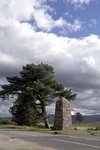
It is a solid tapering rectangular obelisk of rough hewn coursed granite blocks with the lettering carved into them in dressed bands. There is a small roundel with inset curved cross. The top is a stepped pyramidal shape. It has the same 'arts and crafts feel' as the Battle of Harlaw Memorial Monument by the same designer. More Information |
| Bonnie Birken Tree |

Inscribed granite stone, Possibly made for Sir William Cuncliffe Brooks, Laird of Glentanar who |
C
| Corsearder, Corsedarder or Corsedardar Stone |
|---|

A squarish block of reddish granite, about 4'7" in maximum height and 7' in girth, which was dug up many years before 1842 and was erected on top of the hill of Corsedardar, in the belief that it had marked the grave of some eminent person. The stone has been split, and now has the two portions set into a bed of concrete and pieced together by strong iron bands. Tradition says that it marks the spot where Dardanus, a Pictish king, was killed. A stone, 1.5m high, 0.8m wide, and 0.2m thick, generally as described, and possibly a cist slab. Visited by OS (R L) 12 June 1972. from RCAHMS |
| Corsedardar Long Cairn |

Remains of cairn; a curving scarp in the E probably represents the edge of the cairn in this quadrant; otherwise all that can be seen is turf-covered debris, insufficient to estimate the size and shape of the cairn. Part of it was dug into in c1860 when human remains and several silver coins were found. More Information |
| Culblean Memorial |

A modern stone menhir with bronze plaque commemorating a 14th century battle. More Information |
| Culsh souterrain or earth house |

Souterrains are a type of iron-age architecture that seems to have been fairly common in the area that is now Aberdeenshire, the most common assumption is that they were used for storage of grain and other food-stuffs. Souterrain curved and lined with dry stone walls (the walls have been mortared in modern times) and heavy roof slabs. Accessible but the visitor will require a torch to explore the few metres of passageway inside. |
D
| Dry lines , no fish stone |
|---|

A stone inscribed with the words: "Dry lines , no fish" and a cross like mark the inscription showing some trace of colour. Possibly by Sir William Cuncliffe Brooks, Laird of Glentanar who died in 1900. There are several other inscribed stones on the estate many at the sites of springs/wells. |
F
| Formaston Stone |
|---|
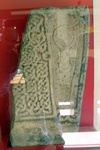
A fragment of a class II Pictish Symbol Stone. It is carved on one face only with a small rimmed ‘mirror’ symbol and part of an interlace filled cross-shaft. The mirror has a long handle with a boss at the end. There are two vertical Ogam inscriptions, Ogam was probably introduced to the Picts from the Gaelic speaking Scots in the 8th Century, they read MAQQoiTALLUORRH and NAHHTVROBBACCAANNEVV. MAQQ may mean son of or descendant of. The oi following is expressed as a small circle. |
G
| Gibbet Stone |
|---|
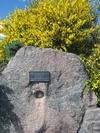
A large asymetrical stone with a socket and plaque. More Information |
| Glen Tanar decorated drinking trough |

A beautifully engraved source. Engraving: possibly by Sir William Cuncliffe Brooks, Laird of Glentanar who |
I
| In the beginning, Tarland |
|---|

Sculpture using engraved granite one large and three smaller stones, that clearly references local precedents particularly from the neolithic and megalithic periods in both the style and decoration of the piece and, of course, the title. More Information |
J
| Jubilee Horse Well |
|---|

In pink granite an inscribed arch, over a horse trough, set into a low wall of dressed stone. The arch keystone decorated with a crown in relief. More Information |
K
| Kincardine ONeil War Memorial |
|---|

The Kincardine o'Neil war memorial stands on the main street in the village near the old church. It commemorates the dead of both World War I & II. It is a rough hewn standing stone onto which is carved a sword pointing downwards. This stone surmounts a rectangular base with inset plaques on the face. On either side are piled loose boulders. It was unveiled September 12th 1920. More Information |
| Kincardine ONeil, street decorative feature |

The backdrop to the old restored St Erchard’s Well with the ruins of the old 1st Century Kirk across the road. Recent addition provided by Aberdeenshire Council along with traffic calming and more defined lay-by’s for parking. More Information |
| Kinord Stone |
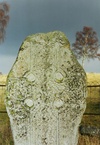
A large class III Pictish cross slab in pink granite 6 feet 3 inches high by 3 feet 1 inch wide carved on one face. More Information |
M
| Migvie Class II Pictish Symbol Stone |
|---|
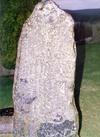
Class II Pictish Symbol Stone 180 x 70 x 38 cm. A low relief cross composed of coarse double interlace is carved in low relief on the east face from the angles of the arms and the top corners of the cross there are short projections ending in rings, which may represent hanging rings. In each quadrant is a symbol in very low relief. Upper left a small clumsy double disc and z rod, upper right even smaller horseshoe and v rod. To the lower right the remains of a mounted figure and two lower left a pair of shears the only known example of this symbol. On the reverse of the stone is a long haired horseman in low relief. This stone is striking by comparison to most Class II Pictish stones in the amateurishness of its execution. I can imagine a customer who could not come at the price demanded by a professional sculptor and instead commissioned a local handyman who was a bit out of his depth. The rider on the reverse seems much more accomplished perhaps a good stencil? More Information |
| Millennium Stone |
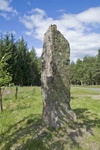
Dedicated on 1st January 2000 with nearly 300 people from local communities of Finzean, Ballogie and Birse in attendance. Anointed with waters from the boundary rivers of the community. The stone came from Craig of Woodend, near the Finzean quarry that was the source of the Birse War Memorial stones, stone donated by the Farquarsons of Finzean estate. More Information |
S
| Snakeswell Stone |
|---|

Carved granite marker with the fascinating wording: "The worm of the still is the deadliest snake on the hill" and a reference to whisky distilling that took place in this area of the and gave its name to a place called Snakeswell. Built by Sir William Cunliffe Brooks, Laird of Glentanar who died in 1900. |
| St Colms well |

Granite boulder marking the well, inscribed with the words "well beloved" and a cross in concentric circles. The well marks the boundary of the parish of Birse to the south. The laird of Glen Tanar Sir William Cuncliffe Brooks, Laird of Glen tanar who |
| ST ERCHARDS WELL (new) |

Well; The original -St Yarchard's Well- is a covered spring of which there is no trace. The water was piped to a public fountain, 400yds to the SW (NO 592 997), which is built of masonry, surmounted by a small iron cross; built in the mid-19thC. it no longer functions. (see related artefact). This new well with continuous running water has been built to the east side of the road, opposite the original site; it is named St Erchard's Well. More Information |
| ST ERCHARDS WELL (old) |
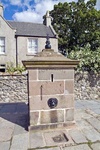
Spelt “St Erchan” in inscription and dated 1858 but recently restored by Alastair Urquhart in 1997. Square masonry housing for fountain with iron lion mask spout and iron finial. |
| St Lesmos Church (new) |

Church; 19thC; built over the ruins of the little mansion of the Lairds of Braeloine. The west extension of the church incorporates an arch and to the north a small bell-tower from this 17th C building. Still in use as a church. To the south of it a small farmstead called Braeloine, consisting of three buildings, is depicted on the OS map of 1867 but not on the 1888 edition. More Information |
T
| Tillylodge viewpoint indicator |
|---|

Offers spectacular views over the River Dee Valley and known as the Queen’s View with claims that Queen Victoria stopped to admire the vista to the distant Mountain of Lochnagar. The Indicator was erected in 1970 by the Deeside Field Club to mark its Jubilee. |
| Tomnaverie (Tarland) Stone Circle |

The recumbent stone circle is a form unique to North East Scotland. |
This content was submitted by external contributors and does not necessarily reflect the views of the University of Aberdeen.
